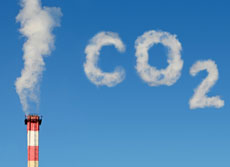The Impact of a Trump Presidency, in Tons of CO2
Legal Planet: Environmental Law and Policy 2016-10-08

One of Trump’s pledges is to eliminate Obama’s Clean Power Plan. That wouldn’t be quite as easy as he thinks, but there’s little doubt that he could do so. So, how much difference would that make? The answer turns out to be 2,470,000,000 tons of additional carbon emissions. That’s a bare minimum; the actual added carbon due to Trump could be much, much higher. Carbon lasts a long time in the atmosphere: about 20% of this extra Trump carbon will still be there in a thousand years. How about that for a lasting legacy?
In case you’re curious, I based this number on the CO2 reductions given in the Regulatory Impact Analysis in comparison with the “base case” of no Clean Power Plan. (Table 3-5) (I assumed that emissions cuts increased linearly from 2020 to 2030, which fits with the 2020, 2025, and 2030 figures.) The additional harm from climate change equates to a cost to society of $75 billion, using the government’s default estimate for the social cost of carbon. I have deliberately made these estimates cautious, using conservative assumptions to decrease the estimate of how much carbon Trump would cause. Here are the assumptions I made to avoid any risk of inflating the estimate:
- US abandonment of the Clean Power Plan (and/or the Paris Agreement) does not affect the carbon cuts other countries make.
- After 2030, the U.S. is back on track with the same level of emissions that would have existed if the Clean Power Plan had succeeded, plus whatever new cuts would otherwise be down the road. That assumes a major change in policy taking effect at the end of the decade and cutting emissions immediately by 415 millions tons. In reality, if he gets to place a lot of conservative judges on the bench, he could probably block EPA from addressing climate change for a much longer time.
- Clinton would merely keep the Clean Power Plan in place, without any additional initiatives to cut carbon emissions. (The impact of picking Trump over Clinton is probably higher than my estimate, however, because Clinton would likely add to Obama’s efforts rather than merely continuing them.)
- All states would have used the rate-based method of compliance, which involves fewer cuts than the mass-based method. (If you don’t know what this means, you probably don’t want to get into this very technical distinction).
- None of Trump’s other policies aimed at increasing production and use of oil, gas, and coal are implemented, so his carbon contribution is limited to eliminating the Clean Power Plan.
These conservative assumptions should at least counter any hypothetical scenarios you can come up with where President Trump doesn’t manage to knock out the Clean Power Plan permanently.
I said earlier that eliminating the Clean Power Plan wouldn’t be as easy as Trump probably believes. He can’t just wave a wand and make it go away. Even if the government stops defending it in the courts, there are intervening parties who would continue to do so. But there are several ways to get rid of it, and it seems like a sure thing that one or another would work:
- Appoint a conservative replacement for Scalia, which probably leads to a 5-4 Supreme Court decision to strike it down.
- Begin a rule making to repeal it. This would take time but would almost certainly succeed.
- With the help of a Republican Congress, pass a statute permanently ending EPA’s ability to address carbon emissions. This would face a Democratic filibuster in the Senate, but that could be avoided in several ways: (1) by using the reconciliation process, (2) by tying it to some urgent appropriation that Democrats wouldn’t dare block, or (3) by using the “nuclear option” to eliminate the filibuster completely. (Maybe I shouldn’t use the term “nuclear option” when discussing Trump, however.)
The big threat isn’t really losing the Clean Power Plan as such. It’s that the entire global effort to reduce carbon emissions would be set back a decade or more. That would mean either higher climate change down the road or the need for much faster, much more expensive emissions cuts later in a rush to make up for lost time. Either way, the cost would be extremely high. Basically, we’d be digging ourselves much deeper into a hole, which would make it much harder to get out afterwards. Assuming that, unlike Trump, you think climate change is real.